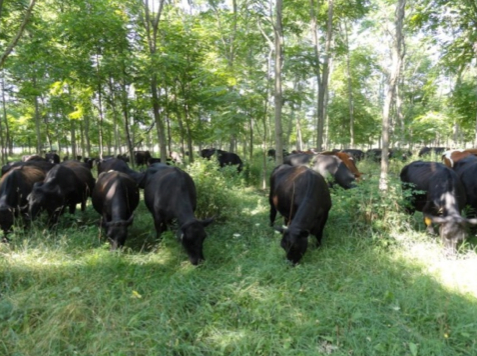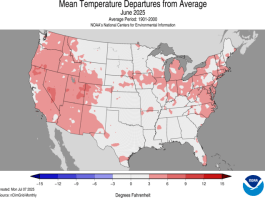Thanks to the University of New Hampshire and Robbin Ray for this article.
 Land use change, like cutting down a forest to make way for agriculture, can be a major contributor to climate change by releasing greenhouse gases into the atmosphere. Researchers at the University of New Hampshire studied a practice known as silvopasture which intentionally preserves trees in pastures where livestock graze. They found that compared to a completely cleared, tree-less, open pasture, the integrated silvopasture released lower levels of carbon dioxide and nitrous oxide and soil carbon storage remained the same, offering a possible alternative for farmers with less climate consequences.
Land use change, like cutting down a forest to make way for agriculture, can be a major contributor to climate change by releasing greenhouse gases into the atmosphere. Researchers at the University of New Hampshire studied a practice known as silvopasture which intentionally preserves trees in pastures where livestock graze. They found that compared to a completely cleared, tree-less, open pasture, the integrated silvopasture released lower levels of carbon dioxide and nitrous oxide and soil carbon storage remained the same, offering a possible alternative for farmers with less climate consequences.
“We talked to a lot of farmers in the Northeast who are interested in the silvopasture approach but there aren’t a lot of data to help guide them through implementation, and responsible and strategic management,” said Alexandra Contosta, research assistant professor at UNH’s Earth Systems Research Center. “We wanted to see if silvopastures made a difference and found that there are benefits to this approach that could help both the farmer and the planet.”
In their study, published in the journal Agriculture, Ecosystems & Environment, researchers conducted land use change experiments in both New Hampshire and New York. In both locations, the land was divided into plots with a reference forest, open pasture and silvopasture. In the silvopasture plots, trees were thinned by 50 to 60% and tree stumps were left in place. Orchard grass, white clover and other foraging sources were planted. After the seeding, either dairy or beef cows were introduced. The team set up meteorological stations in each of the experimental areas, known as treatments, and monitored emissions of carbon dioxide, nitrous oxide and soil carbon storage. The researchers found that the silvopasture offered a reduction in the climate consequences of a typical forest clearing to open pasture, and the climate regulating benefits of silvopasture extended to soil greenhouse gas emissions. However, they did not find any difference in air temperatures between the plots and were not able to document any changes in soil carbon storage among different land use change treatments.
“New England has a lot of trees which can reduce our options for agriculture and our ability to produce our own food,” said Contosta. “So, what is exciting about this study is that it shows silvopasture could be a viable alternative that is also more climate conscious.”
The researchers say that ultimately their study highlights the need to better understand how silvopasture can improve the negative climate consequences of forest clearing for agriculture and has implications for the Northeast and other temperate, forested regions across the globe.




